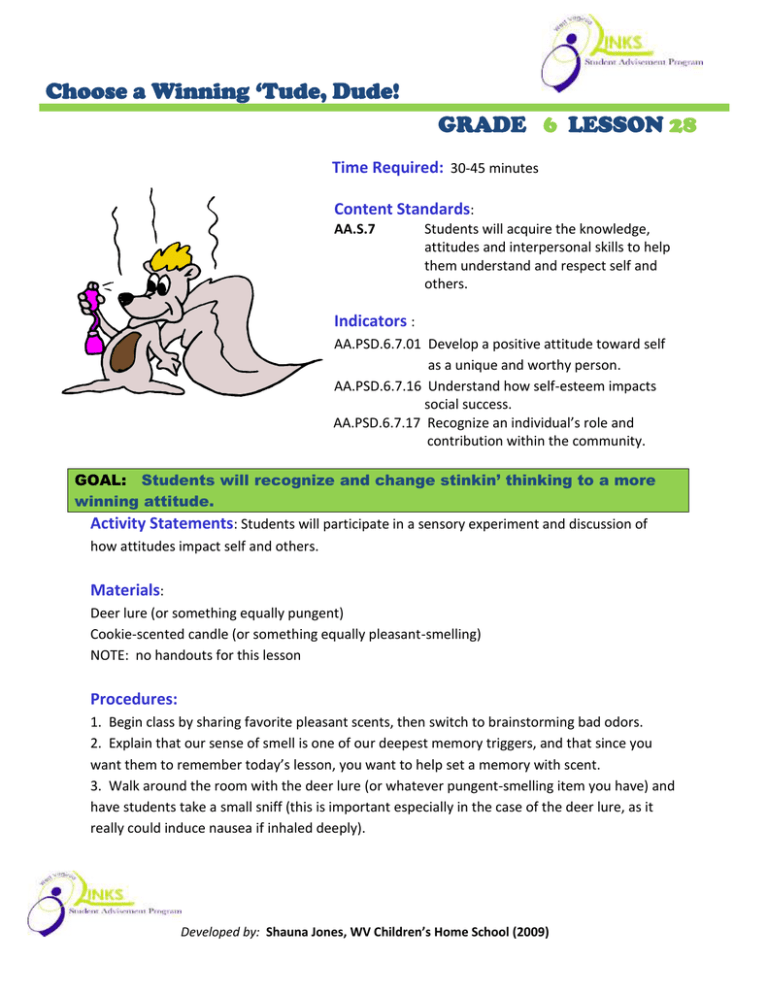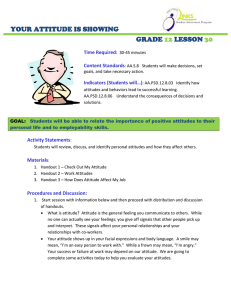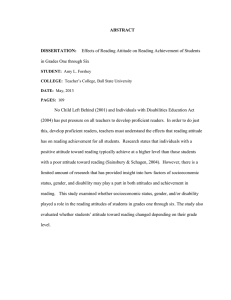Choose a Winning ‘Tude, Dude! GRADE LESSON
advertisement

Choose a Winning ‘Tude, Dude! GRADE 6 LESSON 28 Time Required: 30-45 minutes Content Standards: AA.S.7 Students will acquire the knowledge, attitudes and interpersonal skills to help them understand and respect self and others. Indicators : AA.PSD.6.7.01 Develop a positive attitude toward self as a unique and worthy person. AA.PSD.6.7.16 Understand how self-esteem impacts social success. AA.PSD.6.7.17 Recognize an individual’s role and contribution within the community. GOAL: Students will recognize and change stinkin’ thinking to a more winning attitude. Activity Statements: Students will participate in a sensory experiment and discussion of how attitudes impact self and others. Materials: Deer lure (or something equally pungent) Cookie-scented candle (or something equally pleasant-smelling) NOTE: no handouts for this lesson Procedures: 1. Begin class by sharing favorite pleasant scents, then switch to brainstorming bad odors. 2. Explain that our sense of smell is one of our deepest memory triggers, and that since you want them to remember today’s lesson, you want to help set a memory with scent. 3. Walk around the room with the deer lure (or whatever pungent-smelling item you have) and have students take a small sniff (this is important especially in the case of the deer lure, as it really could induce nausea if inhaled deeply). Developed by: Shauna Jones, WV Children’s Home School (2009) Choose a Winning ‘Tude, Dude! GRADE 6 LESSON 28 4. Immediately follow the pungent scent by having them smell the candle (or whatever pleasant-smelling item you have; this should be able to be inhaled without the precaution placed on the other scent). 5. Explain that our attitudes give of an “aroma” to others as well. Negative attitudes are like the pungent odor; people don’t want to be around it for very long. Conversely, positive attitudes draw people in and help generate a more pleasant environment. Remind them that our attitudes come from our thoughts, so we can choose to change our “stinkin’ thinking” into more pleasant, winning thinking. Remind them that it sometimes takes many attempts before this comes more naturally, but that like any skill, the more we practice it, the easier it usually becomes. 6. Have students “pair and share” examples of “stinkin’ thinking” in the following life areas: chores, homework, studying, friendship conflict, sports or hobbies. Allow 2 minutes for each pair and share segment (or whatever amount of time you find reasonable). IF TIME PERMITS HAVE STUDENTS DO ROLE PLAY LISTED AS AN EXTENSION ACTIVITY. Discussion: 1. What is the best way to change your attitude? 2. Have you ever awaken in a bad mood? What can you do to change a bad mood in the morning before you get to school? 3. What are you going to remember most from this lesson and why? Additional Resources: Free mini-book on stinking thinking: http://changeyourstinkingthinking.com/ Article on stinking thinking: http://www.bullseye-living.com/427/how-to-end-addiction-to-stinkin-thinkin/ Article on helping kids avoid the stinking thinking trap: http://micheleborba.ivillage.com/parenting/archives/2009/09/solutions-to-turnpessimistic.html Extension Activities: Students could role play one or more of the following situations, first demonstrating a negative attitude, then changing it to a positive attitude: * mom says you can’t play your video game until you clean your room * teacher assigns homework over the weekend * best friend is acting distant * didn’t make the sports tea Developed by: Shauna Jones, WV Children’s Home School (2009)








